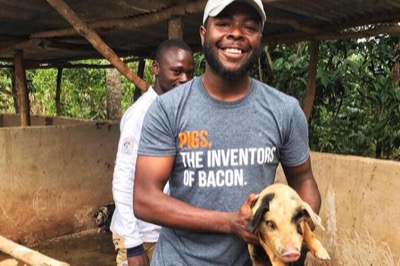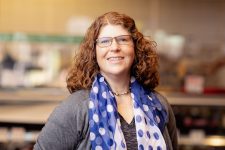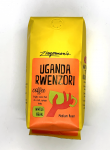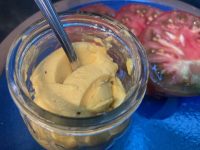An interview with the most interesting man in pork world: Swine Specialist, “Pork” Rhyne Cureton

A sneak peak at one of the speakers at the 10th Anniversary Camp Bacon Main Event on Friday, May 31 at Cornman Farms!
Ari: Looking over your resume, you’ve done a whole lot! If I read it right, you graduated from North Carolina A&T. You were a “Swine Specialist” in Uganda and Tanzania. You were an intern for the Environmental Defense Fund and the Rachel Carson Council, and then later for the National Pork Council—those first two don’t really seem like they’d normally go with the latter? You’ve spoken at a mess of conferences. Oh yeah, you also created something called Swine and Design? That’s quite a life. Can you give us a bit of the Rhyne Cureton story?
Rhyne: I want to say it started when I was probably . . . I guess in my early teenage years. I was that kid who was glued to the television, watching the Discovery Channel and Animal Planet and all that. I love animals! And that helped reinforce this idea that animals are supposed to be part of a natural environment. That animals are a part of nature. They should be in a natural environment. Because of all of that, I really embraced nature. And I started looking outside and brought home some critters and my mom would freak out. But I had a really high appreciation for animals and the environment.
I went to North Carolina A&T as an animal science major. I went into it thinking I might be a veterinarian one day. It hadn’t dawned on me that “animal science” was also a part of agriculture. I realized it’s not just animals in the wild, it’s also farm animals. Land Grant (like N.C. A&T) colleges are designed to help you see the greater scheme of things. It’s not just farming. It’s econ, it’s research, it’s geopolitics, it’s food. It encompasses everything we do as a culture and civilization and a greater humanity. I really came to appreciate the multifaceted nature of agriculture. It really showed me what the full breadth of agriculture was, that I could play with it forever and never get bored!
I went to the USDA World Outlook Forum. It’s an event where people from all over the world come together to talk agriculture on a global policy scale. I was one of 20 undergrad students to be an essay winner. Then I realized that this agriculture thing was about the whole world. That agriculture is the center of everything. Nothing else can survive without it.
Being immersed in animal science, I started to notice that most of the employers who would come recruit were these giant multinationals. It just didn’t resonate with me . . . it didn’t connect with my childhood belief that animals were a part of nature. I realized that they were essentially preparing us for a job in an industrial model. They look at themselves as the saviors of the world . . . it was the opposite of what I’d been thinking. It’s like I’d been on two sides of the same coin. But I knew that polarizing myself wasn’t gonna help.
So I thought, OK! I’m gonna take a gap year where I can actually experience agriculture. Where I can get outdoors and work . . . so I worked on farms in Texas and North Carolina . . . they had cows, pigs, chickens, ducks . . rabbits. Really diversified farms. It was really good to be able to work with livestock . . . and to see what it was like to practice what I’d been learning about. I wanted to be an advocate, but one way of advocating is to actually do the work. When you do that, you come from a position of knowledge and experience. I really wanted to make sure that I had that real life experience! While I was in Texas I had the opportunity to have a chance to raise these pigs. They were English Blacks.
Ari: They’re the hogs that were really popular in England in the late 19th and early 20th centuries? Big hogs, with floppy, black ears, right?
Rhyne: Those are the ones. We had a sow and a boar. It was really interesting but very rough. The property wasn’t really designed for pig farming. The people who were there didn’t really particularly like pigs . . . so no one there really knew how to raise them. They were trying, but they didn’t really know what they were doing. And meanwhile, I was trying to figure it out without any help, on the fly. They’re really intelligent animals, so it was frustrating not to be able to work with them properly. The breaking point was one hog . . . she was about 400 or 500 pounds . . . I had a ‘day off”. . . and she broke out. When I came back and I put her in the isolation tent. . . I kept checking behind myself to see her . . . she ended up charging right at the gate and lifted the whole, really heavy iron gate right off the hinge and throwing it up into the air! It’s crazy how powerful they are!
That’s when I decided to stop, pause, and think for a bit. I just decided to love the hogs so hard that I would be able to understand them. Taking that approach, an approach of humility, allowed me to stop banging my head against the wall and realize what was going on.
A lot of the problem wasn’t the pigs at all. It was how they were being managed. So just spending time around them and seeing what their needs were . . . there’s so much more than just food and water . . . what’s the context that they’re being raised in? Some of the pigs have individual needs. What are those? Pinpointing what was wrong, not pinpointing the pig.
Ari: So how did you go from working on a Texas farm to the National Pork Board?
Rhyne: It was around that time that I had a chance to work with the National Pork Board doing social media for them. That exposed me to the “modern pig farmers.” I learned that my wording had to be very sensitive—there were words I just wasn’t allowed to use. Like I couldn’t say “Operation” or “crate.” Those were considered negative words. That was really eye-opening. It’s not ever the kind of agriculture I want to do. So during my visit to them in Iowa, I asked, “How can I represent you when I don’t agree with a lot of what you’re doing?” I wasn’t coming from a place of malice, I was just confused. What they said was, “Look, just give us a fair chance. You see and you know what we do. And you know the heart behind what we do. Because some people think that we’re malicious or that we try to hurt animals.” That helped me realized how important it is to build relationships even with folks who work in ways that aren’t how I would do it.
In the regenerative agriculture world, a lot of people like to demonize and polarize. But there are a lot of socioeconomic issues that big agriculture farmers help with. It’s important to make it a distinction between the two styles of agriculture, but not to the point where you’re making fun of each other or pointing fingers. It’s not just one person’s truth but what’s the greater truth, the truth that’s outside of any one person’s reality.
Ari: Sounds like a good message for the country overall right now!
Rhyne: Later, I got a chance to speak at my first conference ever. It was the National Women in Agriculture Association. It was in Houston back in 2017. Through that, I got a chance to go to Uganda… one of the people in the presentation was the director of the organization that does work to empower East Africans through improvement of agriculture.
I learned there that it’s more about how do we work with appropriate technology . . . not just throwing tech at someone in East Africa who last season used a hand hoe. The idea was to help each village to develop itself to reinvest in the community. My work was training the pig farmers that were there. My first trip, I think, I focused too much on animal welfare. The idea of it wasn’t clicking with the farmers at all. Eventually, I realized I needed to teach in a different way to make it work. I’d never connected animal welfare to economic opportunities before. So the next time I went back to Uganda, I focused on how animal welfare is a good business practice. Then I could show them how animal welfare would help them to run their farming better. And then it really resonated with them. That let me see it at work on a really small scale!
Ari: And from there?
Rhyne: I started speaking here in the U.S. to new organic farmers. Unfortunately, a lot of them too often ignore the business end of agriculture. And because of that, a lot of ‘em are having to abandon what they’re doing . . . You can’t make good business decisions without knowing how you did last season or what you’re doing now.
Ari: What’s a good example?
Rhyne: Ham steak! I love ham steak. But a lot of people don’t even know what it is. And I realized that it won’t matter how much I love it, if the customer isn’t going to buy it. On the other hand, you can sell sausage a lot faster than a ham steak. And that’s what we started to teach farmers. Farmers started to realize, if they make sausage they can get more money rather than letting these undesirable cuts sit in their freezers. Starting to understand that what you do isn’t just what you’re personally interested in.
The North Carolina Pork Council Conference has put me on their policy committee. So hopefully we can make some changes that will have a positive impact. And I’m doing some training to become a USDA Ag Inspector. The training is crops first . . . so my connection . . . there is future organic farmer grants.
Ari: What are you gonna talk about at Camp Bacon?
Rhyne: Kind of for me . . . being in the environment I am in regenerative agriculture, let’s be honest—there’s just a lot of white people in it. Which made me wonder, “Where’s my identity? How do I cultivate my identity within that context?” It’s a challenging situation. There are a lot of people like my mom’s generation and my grandmother’s generation. . . thinking of those black farmers . . .they warn me to stay away from it.
It can be discouraging. But just seeing that I’ve been blessed to have what I have, that I can use my ability to create a stronger network to help folks. Just sharing my journey of not having any background in agriculture. . . really finding a marriage of the commercial pig farming with regenerative agriculture, that’s a great thing! That’s what I want to share. That there’s a way to do this that honors everyone.
Ari: I was reading Leah Penniman’s book, Farming While Black (which is very good!) and I saw you in there!
Rhyne: Leah, she had called me I think a year and a half ago—it was really crazy. She was looking for black farmers and she couldn’t find anyone . . . she found one farmer in Vermont who followed me on Instagram . . . and he said, “Wait, you don’t know ‘Pork Rhyne?’” And that’s how she and I got connected. She’s a pretty awesome person. Her work is really vital to the discussion of equity and race and embracing the things that were hard to swallow. The idea of working the land, not like we can now today with a sense of rejoicing, but rather out of fear and terror and enslavement. . . really historically divorced us, as a people, from the land. Her book helps remind people that African Americans belong in agriculture. But not just as farmhands or workers, but as business owners and farm owners. It’s trying to really turn us from victims into people who aren’t going to accept ‘what is,’ and instead put things in our own hands!
Ari: Ok, what about the project with painting and pigs?
Rhyne: I love art! I’m a huge art appreciator! But art for me actually started out with a lot of hate. I started doing art out of bitterness towards my father. He was an artist, and the abandonment he threw me into . . . I ended up with a really unhealthy relationship with art. But over time I let the resentment melt off me . . . and I changed my relationship with art. Around 2017 . . . that was when I set up the program Swine and Design. There are 2.5 million people in Charlotte where I live. One of the community colleges I’m involved with has nine different campuses. I did demos and festivals on all the campuses—Swine and Design by Rhyne. The idea came from my friends. I always wanted to teach people how to paint. And it was really interesting to do pigs as the focal point for the art . . .
We had a picture of that same pig I told you about, the big English Black that blew the gate off the hinges and I would give people paint and paper to work on and ask them to paint the pig. It was an opportunity for people to paint, of course. But covertly, I’m also getting the seeds of local food and regenerative agriculture into their minds while they’re learning to paint a pig! And in the process I got them asking questions about our food system. That allowed people to have insight that they wouldn’t have had. And I cooked bacon and sausage and ribs and they got to taste it . .. so it was the combination of all the senses in one two-hour event!
I think next year I’ll come back to Camp Bacon again and we’ll do Swine and Design!!
Ari: Before I wrap up here, what’s your favorite way to eat bacon?
Rhyne: With a maple glazed cake-based donut with a caramel drizzle ☺!




Zingerman’s Art for Sale